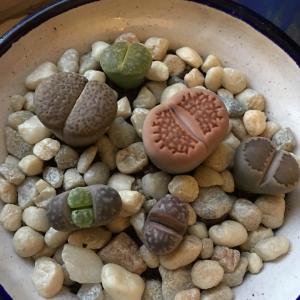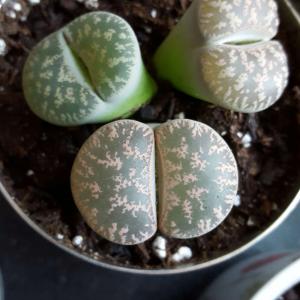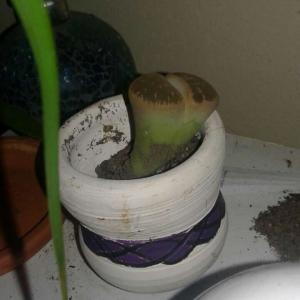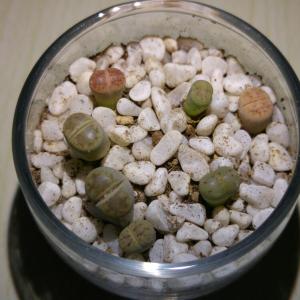文章
Miss Chen
2017年09月22日

Los Lithops, son cactus o suculentas que por su forma similar a las piedras del desierto se las llama popularmente piedras vivientes o cactus piedra. Al género Lithops pertenecen unas 40 especies de pequeñas plantas de la familia de las Aizoáceas todas nativas del sur de África, Sudáfrica, Namibia y Botswana.
El lithops consta de una larga raíz pivotante, un tallo subterráneo corto y dos hojas que forman la parte aérea de la planta. Su crecimiento es muy lento y son ideales para su cultivo en interio. No hace falta cambiarlas de maceta en 10 o 20 años.

Su altura es de unos 5 cm y tiene un diámetro de entre 1 y 3 cm. Por entre la ranura existente entre las dos hojas aparece en otoño la flor (amarilla o blanca) que tiene cierta similitud con la margarita y un diámetro de entre 2 y 4 cm.

Es una planta muy fácil de cultivar y no requiere apenas cuidado alguno. Necesitan una exposición muy luminosa pero es mejor que no reciban el sol directo, sobre todo en las horas centrales del día. También son muy sensibles al frío. El suelo ideal para su cultivo será el formado por una mezcla de sustrato para cactus, arena fina y perlita. Sólo debe regarse cuando el suelo esté totalmente seco y cada 15 días en primavera, tras la renovación de las hojas y en otoño antes de la floración.

El riego debe suspenderse por completo en el periodo de latencia (verano), durante el invierno y mientras se produce la renovación de las hojas. En verano y sólo una vez se le puede fertilizar con un abono rico en fósforo que fomentará la floración. Cada 2-3 años hay que transplantalo y la mejor época será cuando las viejas hojas se hayan marchitado y estén apareciendo las nuevas. Su principal problema suele ser la pudrición de las raíces y el ataque de roedores y áfidos cuando se cultiva en exterior.




El lithops consta de una larga raíz pivotante, un tallo subterráneo corto y dos hojas que forman la parte aérea de la planta. Su crecimiento es muy lento y son ideales para su cultivo en interio. No hace falta cambiarlas de maceta en 10 o 20 años.

Su altura es de unos 5 cm y tiene un diámetro de entre 1 y 3 cm. Por entre la ranura existente entre las dos hojas aparece en otoño la flor (amarilla o blanca) que tiene cierta similitud con la margarita y un diámetro de entre 2 y 4 cm.

Es una planta muy fácil de cultivar y no requiere apenas cuidado alguno. Necesitan una exposición muy luminosa pero es mejor que no reciban el sol directo, sobre todo en las horas centrales del día. También son muy sensibles al frío. El suelo ideal para su cultivo será el formado por una mezcla de sustrato para cactus, arena fina y perlita. Sólo debe regarse cuando el suelo esté totalmente seco y cada 15 días en primavera, tras la renovación de las hojas y en otoño antes de la floración.

El riego debe suspenderse por completo en el periodo de latencia (verano), durante el invierno y mientras se produce la renovación de las hojas. En verano y sólo una vez se le puede fertilizar con un abono rico en fósforo que fomentará la floración. Cada 2-3 años hay que transplantalo y la mejor época será cuando las viejas hojas se hayan marchitado y estén apareciendo las nuevas. Su principal problema suele ser la pudrición de las raíces y el ataque de roedores y áfidos cuando se cultiva en exterior.




0
0
文章
Dummer. ゛☀
2017年09月21日

Living Stones (Lithops) are unusual succulents that have evolved to resemble the pebbles and rocks that litter their native habitats through southern Africa. These very small plants hug the ground and grow extremely slowly. It can take years for a plant to eventually fill its pots with new leaves. Structurally, Lithops are comprised of two fused leaves above ground that connect to an underground stem with a long root.
The leaves are extremely thick and the degree of fusion depends on the species. Some species appear to be a single leaf, with hardly any evidence of the leaf fusion, while others are deeply lobed to the level of the soil. These plants are great collectibles, but require a careful hand with the water. Too much water and the leaves will burst or the plant will die from beneath. If you provide them with good conditions, they will flower in mid-to late summer with white and yellow daisy-like flowers that emerge from between the leaves.

Growing Conditions
Light: Lithops thrive in full sunlight, so provide as much light as possible. Weak light will cause elongated leaves and washed out patterns on the leaves.
Water: Lithops have a definite annual cycle that should be carefully followed. In the summer, as the plants are dormant, it is okay to lightly water them if the leaves shrivel. In general, plants should not be watered during their summer dormancy or during the winter.
Temperature: Warm in summer (household temperatures are fine) and colder in winter months (down to 55˚F/13˚C at night).
Soil: Use a cactus mix or very fast-draining potting soil mixed with sand.
Fertilizer: Fertilizer is not necessary.

Propagation
Most Lithops species can be propagated from seeds. Seedlings typically take two to three years to reach maturity and begin flowering.

Repotting
Lithops are very slow growing, small plants, which makes them ideal as houseplants (once you get the hang of their watering schedule). Older plants form attractive clumps of “pebbles” in their pots, which are highly prized. In general, plants should only be repotted if there are cultural problems (soggy soil) or the plant has outgrown its dish container, which will only happen every several years.

Grower’s Tips
Lithops develop a new set of leaves every year, with new leaves emerging in the fall and growing through the winter and into the summer. In late summer, the plant will go dormant and water should be severely restricted to prevent bursting leaves. The flowers appear near the end of summer or fall, first showing up as a small bud forcing its way between the leaves and growth will begin again. It’s safe to water during this period. Heading into the winter, the leaves will still be growing, but you should stop watering, even as the older leaves shrivel up and encase the new growth. In the spring, it’s safe to begin lightly watering again as the plant begins to grow again, heading toward their summer dormancy period and the emergence of new leaves in the fall.
The leaves are extremely thick and the degree of fusion depends on the species. Some species appear to be a single leaf, with hardly any evidence of the leaf fusion, while others are deeply lobed to the level of the soil. These plants are great collectibles, but require a careful hand with the water. Too much water and the leaves will burst or the plant will die from beneath. If you provide them with good conditions, they will flower in mid-to late summer with white and yellow daisy-like flowers that emerge from between the leaves.

Growing Conditions
Light: Lithops thrive in full sunlight, so provide as much light as possible. Weak light will cause elongated leaves and washed out patterns on the leaves.
Water: Lithops have a definite annual cycle that should be carefully followed. In the summer, as the plants are dormant, it is okay to lightly water them if the leaves shrivel. In general, plants should not be watered during their summer dormancy or during the winter.
Temperature: Warm in summer (household temperatures are fine) and colder in winter months (down to 55˚F/13˚C at night).
Soil: Use a cactus mix or very fast-draining potting soil mixed with sand.
Fertilizer: Fertilizer is not necessary.

Propagation
Most Lithops species can be propagated from seeds. Seedlings typically take two to three years to reach maturity and begin flowering.

Repotting
Lithops are very slow growing, small plants, which makes them ideal as houseplants (once you get the hang of their watering schedule). Older plants form attractive clumps of “pebbles” in their pots, which are highly prized. In general, plants should only be repotted if there are cultural problems (soggy soil) or the plant has outgrown its dish container, which will only happen every several years.

Grower’s Tips
Lithops develop a new set of leaves every year, with new leaves emerging in the fall and growing through the winter and into the summer. In late summer, the plant will go dormant and water should be severely restricted to prevent bursting leaves. The flowers appear near the end of summer or fall, first showing up as a small bud forcing its way between the leaves and growth will begin again. It’s safe to water during this period. Heading into the winter, the leaves will still be growing, but you should stop watering, even as the older leaves shrivel up and encase the new growth. In the spring, it’s safe to begin lightly watering again as the plant begins to grow again, heading toward their summer dormancy period and the emergence of new leaves in the fall.
3
2
成长记
Succulentplant101
2017年09月18日

I new added a "Lithops" in my "garden"
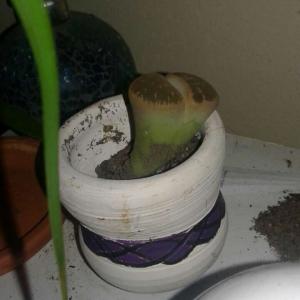

1
0
cclecombe:I love these guys, I call them little booties whenever we see them 😂
文章
Dummer. ゛☀
2017年08月23日

Lithops plants are often called “living stones” but they also look a bit like cloven hooves. These small, split succulents are native to the deserts of South Africa but they are commonly sold in garden centers and nurseries. Lithops thrive in compacted, sandy soil with little water and blistering hot temperatures. While relatively easy to grow, a little information on lithops will help you learn how to grow living stone plants so that they thrive in your home.

Information on Lithops
There are numerous colorful names for plants in the Lithops genus. Pebble plants, mimicry plants, flowering stones, and of course, living stones are all descriptive monikers for a plant that has a unique form and growth habit.
Lithops are small plants, rarely getting more than an inch above the soil surface and usually with only two leaves. The thick padded leaves represent the cleft in an animal’s foot or just a pair of green to grayish brown stones clustered together. The plants have no true stem and much of the plant is underground. The resulting appearance has the double attribute of confusing grazing animals and conserving moisture.

Lithops Succulent Adaptations
below ground, it has minimal foliar space to gather sun’s energy. As a result, the plant has developed a unique way of enhancing solar collection by means of “windowpanes” on the surface of the leaf. These transparent areas are filled with calcium oxalate, which creates a reflective facet that increases light penetration. Another fascinating adaptation of lithops is the long life of the seed capsules. Moisture is infrequent in their native habitat, so the seeds can remain viable in the soil for months.

How to Grow Living Stones Plants
Growing living stones in pots is preferred for most but the hottest zones. Lithops need a cactus mix or potting soil with some sand incorporated. The potting media needs to dry before you add moisture and you must place the pot in as bright an area as possible. Place the plant in a southern facing window for optimum light entry. Propagation is through division or seed, although seed grown plants take many months to establish and years before they resemble the parent plant. You can find both seeds and starts on the Internet or at succulent nurseries. Adult plants are common at even big box nurseries.

Lithops Care
Lithops care is easy as long as you remember what type of climate the plant originates from and mimic those growing conditions. Be very careful, when growing living stones, not to overwater. These little succulents do not need to be watered in their dormant season, which is fall to spring. If you wish to encourage flowering, add a diluted cactus fertilizer in spring when you commence watering again. Lithops plants do not have many pest problems, but they may get scale, moisture gnats and several fungal diseases. Watch for signs of discoloration and evaluate your plant often for immediate treatment.

Information on Lithops
There are numerous colorful names for plants in the Lithops genus. Pebble plants, mimicry plants, flowering stones, and of course, living stones are all descriptive monikers for a plant that has a unique form and growth habit.
Lithops are small plants, rarely getting more than an inch above the soil surface and usually with only two leaves. The thick padded leaves represent the cleft in an animal’s foot or just a pair of green to grayish brown stones clustered together. The plants have no true stem and much of the plant is underground. The resulting appearance has the double attribute of confusing grazing animals and conserving moisture.

Lithops Succulent Adaptations
below ground, it has minimal foliar space to gather sun’s energy. As a result, the plant has developed a unique way of enhancing solar collection by means of “windowpanes” on the surface of the leaf. These transparent areas are filled with calcium oxalate, which creates a reflective facet that increases light penetration. Another fascinating adaptation of lithops is the long life of the seed capsules. Moisture is infrequent in their native habitat, so the seeds can remain viable in the soil for months.

How to Grow Living Stones Plants
Growing living stones in pots is preferred for most but the hottest zones. Lithops need a cactus mix or potting soil with some sand incorporated. The potting media needs to dry before you add moisture and you must place the pot in as bright an area as possible. Place the plant in a southern facing window for optimum light entry. Propagation is through division or seed, although seed grown plants take many months to establish and years before they resemble the parent plant. You can find both seeds and starts on the Internet or at succulent nurseries. Adult plants are common at even big box nurseries.

Lithops Care
Lithops care is easy as long as you remember what type of climate the plant originates from and mimic those growing conditions. Be very careful, when growing living stones, not to overwater. These little succulents do not need to be watered in their dormant season, which is fall to spring. If you wish to encourage flowering, add a diluted cactus fertilizer in spring when you commence watering again. Lithops plants do not have many pest problems, but they may get scale, moisture gnats and several fungal diseases. Watch for signs of discoloration and evaluate your plant often for immediate treatment.
1
3
文章
Dummer. ゛☀
2017年08月15日

Fenestraria baby toes really does look a bit like the tiny digits of an infant. The succulent plant is also known as living stones, with larger plants producing small rock-like protuberant leaves. In fact, it shares the same family as Lithops, which is also referred to as living stones. The plant is widely available at nurseries and a live object of artistic interest. Instructions on how to grow a baby toes plant are easy enough for children and young people, who adore the fascinating little plant.

Baby Toes Succulent Description
Baby toes plants (Fenestraria rhopalophylla) are native to subtropical desert zones. They require bright sun and moderate water in well-drained soil with plenty of gritty matter. Mother Nature engineered them to be very tolerant of low nutrient soils with extreme weather conditions. The perennial succulents form columns of leaves that are thick and rise up like small toes with flattened tops. The tops possess a translucent membrane over the top of the leaf. The vertical leaves may be mistaken for stems but are really modified foliage. Baby toes succulent may be mottled, grayish green to fully gray or even brown.

Baby Toes Plant Propagation
Like many succulents, Fenestraria baby toes produces offsets as the clusters of leaves mature and spread. These are easy to divide from the main clump and will readily produce another plant. Baby toes bloom in late summer to autumn with daisy-like flowers in a variety of hues. The seeds from the plant germinate sporadically and grow extremely slowly. Faster baby toes plants are achieved by dividing off the side growth.

How to Grow a Baby Toes
Starting baby toes from seed can be rewarding but you need a few key elements for a successful venture. First, the container should be shallow and well-draining. Make up a growing medium with equal parts coir, potting soil, sand, fine gravel and perlite. Moisten the mixture in the pot lightly and strew the seeds evenly on the surface of the soil. Sprinkle a light dusting of sand over the seeds. They will push the sand out of their way as the seedlings emerge. Cover the pot with clear plastic and place in a low light area until germination. Mist the plants after they emerge and remove the cover for half an hour daily to prevent fungal growth.

Care of Baby Toes
Move pots to a fully sunlit area where temperatures range at least 65 F. (19 C.). As with most succulent plants, the biggest problem is over or under watering. While Baby toes are tolerant of drought conditions, they need moisture to store in their leaves to sustain them during the growing season. Baby toes have few pest or disease problems, but do watch out for rot when plants are over watered or in pots that don’t drain well. Fertilize in early spring with a half dilution of cactus and succulent food. Suspend watering in the dormant season from November to February. Other than that, care of baby toes, is so easy the infant whose toes they resemble could almost grow these great little succulents.

Baby Toes Succulent Description
Baby toes plants (Fenestraria rhopalophylla) are native to subtropical desert zones. They require bright sun and moderate water in well-drained soil with plenty of gritty matter. Mother Nature engineered them to be very tolerant of low nutrient soils with extreme weather conditions. The perennial succulents form columns of leaves that are thick and rise up like small toes with flattened tops. The tops possess a translucent membrane over the top of the leaf. The vertical leaves may be mistaken for stems but are really modified foliage. Baby toes succulent may be mottled, grayish green to fully gray or even brown.

Baby Toes Plant Propagation
Like many succulents, Fenestraria baby toes produces offsets as the clusters of leaves mature and spread. These are easy to divide from the main clump and will readily produce another plant. Baby toes bloom in late summer to autumn with daisy-like flowers in a variety of hues. The seeds from the plant germinate sporadically and grow extremely slowly. Faster baby toes plants are achieved by dividing off the side growth.

How to Grow a Baby Toes
Starting baby toes from seed can be rewarding but you need a few key elements for a successful venture. First, the container should be shallow and well-draining. Make up a growing medium with equal parts coir, potting soil, sand, fine gravel and perlite. Moisten the mixture in the pot lightly and strew the seeds evenly on the surface of the soil. Sprinkle a light dusting of sand over the seeds. They will push the sand out of their way as the seedlings emerge. Cover the pot with clear plastic and place in a low light area until germination. Mist the plants after they emerge and remove the cover for half an hour daily to prevent fungal growth.

Care of Baby Toes
Move pots to a fully sunlit area where temperatures range at least 65 F. (19 C.). As with most succulent plants, the biggest problem is over or under watering. While Baby toes are tolerant of drought conditions, they need moisture to store in their leaves to sustain them during the growing season. Baby toes have few pest or disease problems, but do watch out for rot when plants are over watered or in pots that don’t drain well. Fertilize in early spring with a half dilution of cactus and succulent food. Suspend watering in the dormant season from November to February. Other than that, care of baby toes, is so easy the infant whose toes they resemble could almost grow these great little succulents.
2
2



